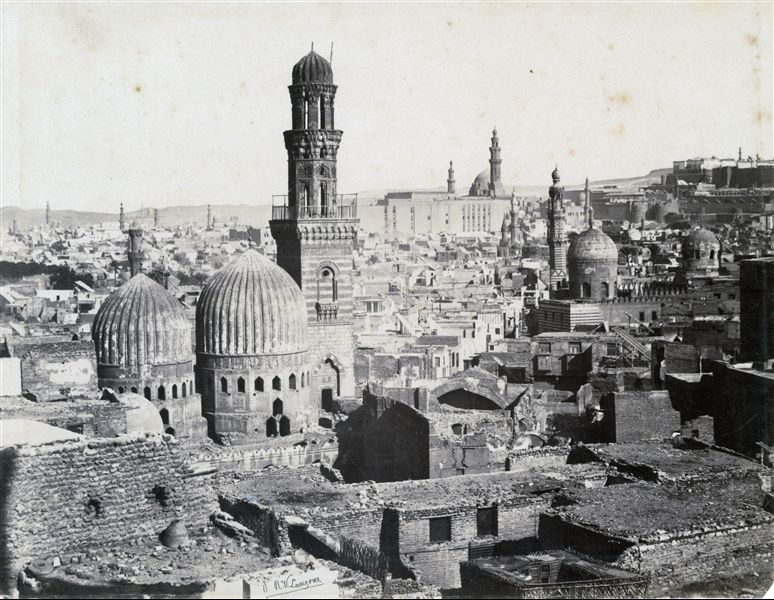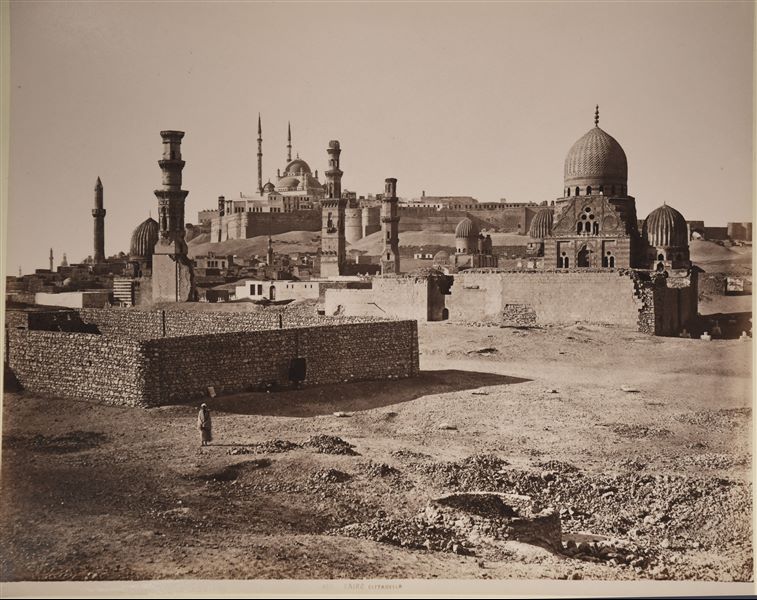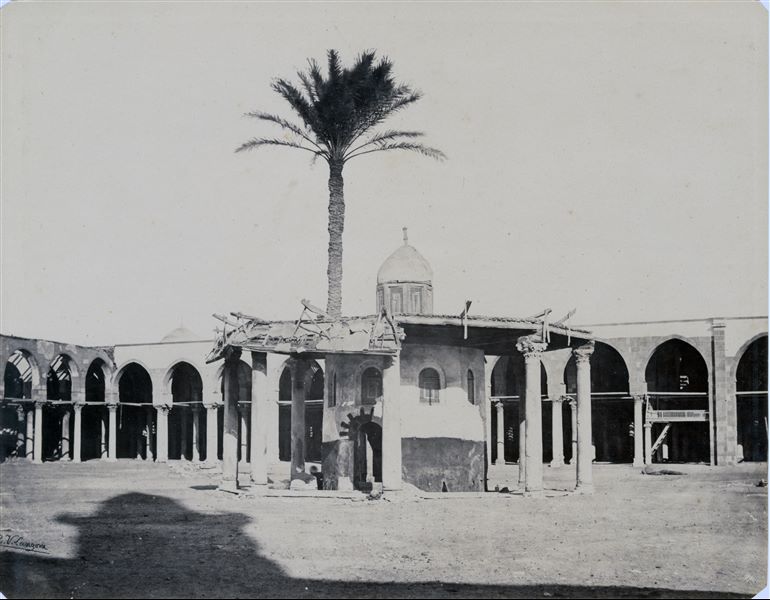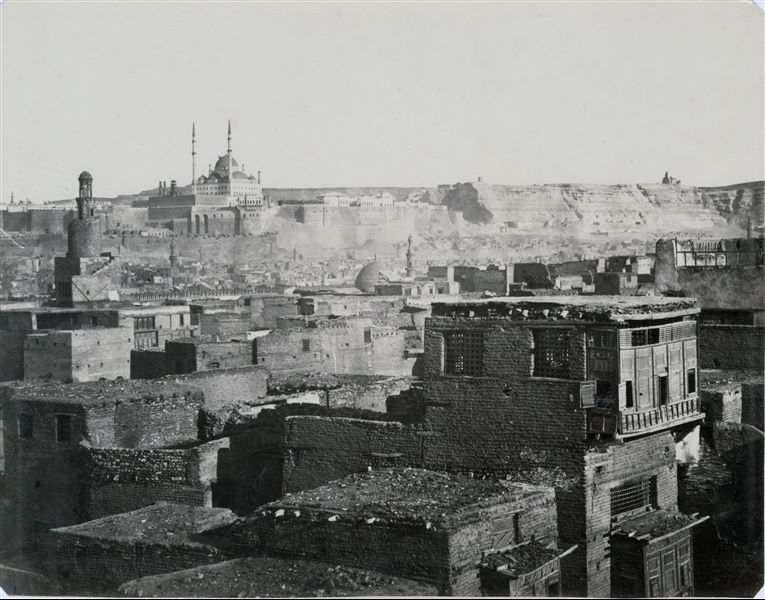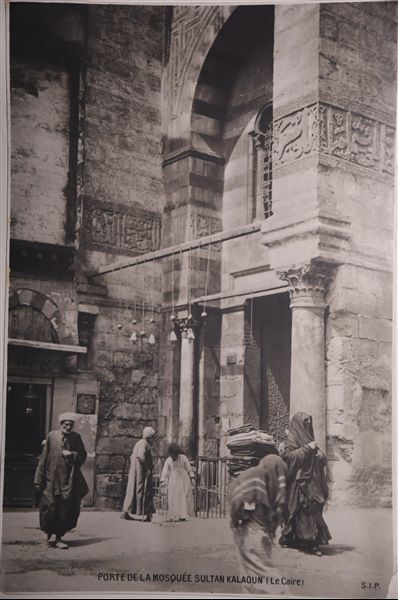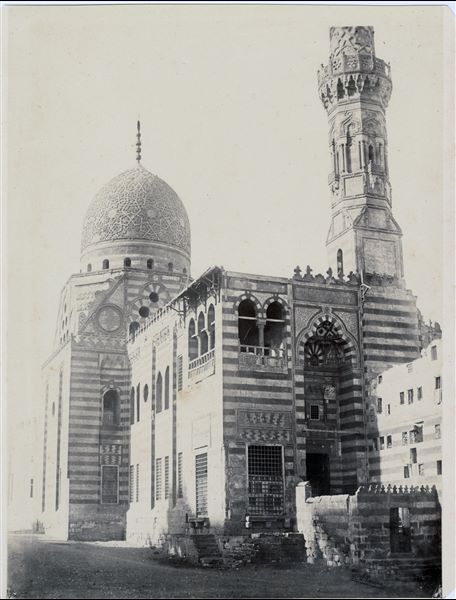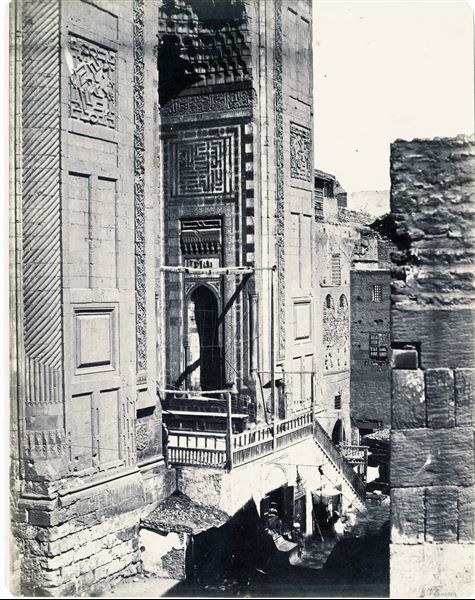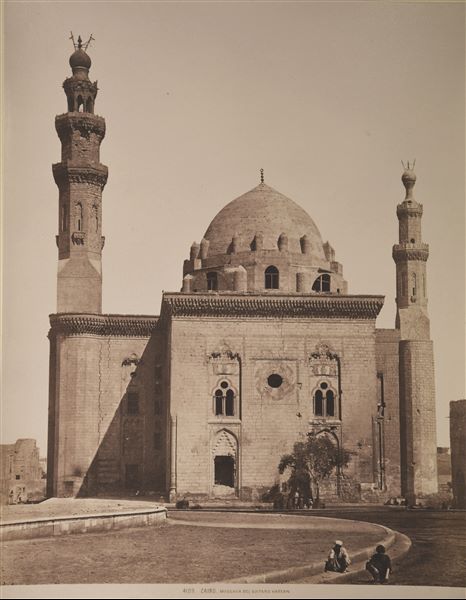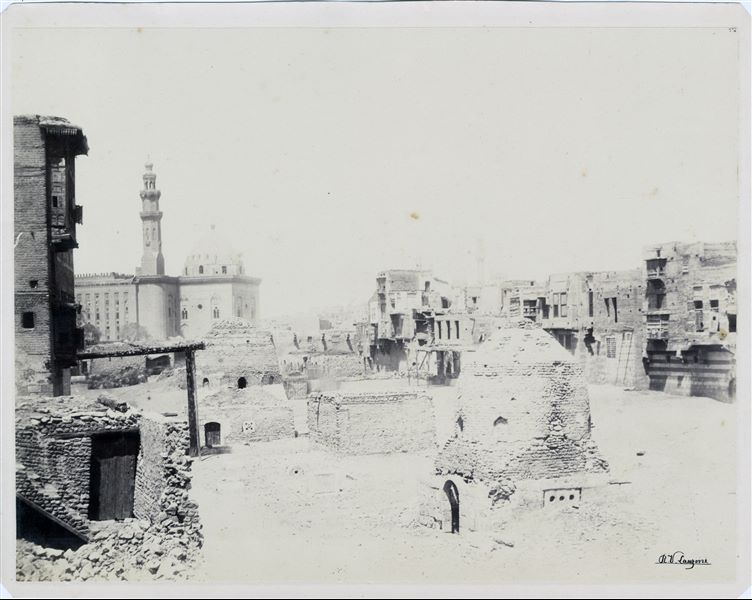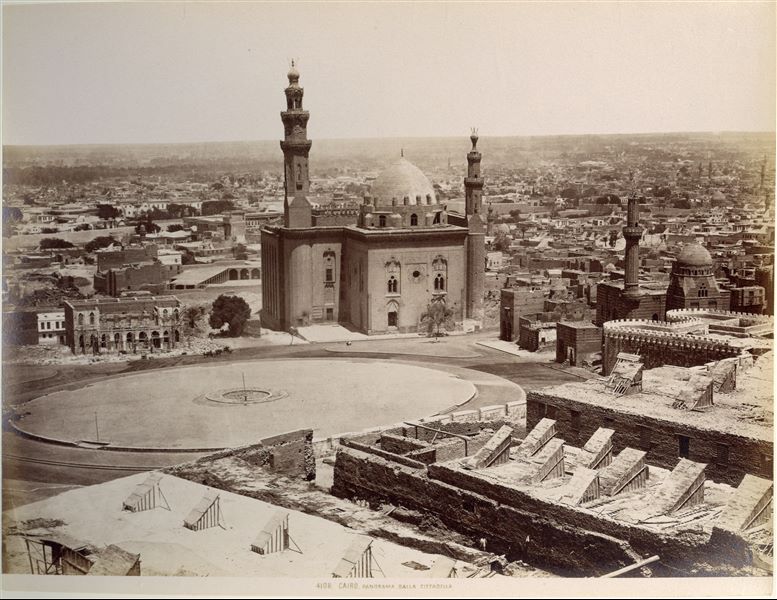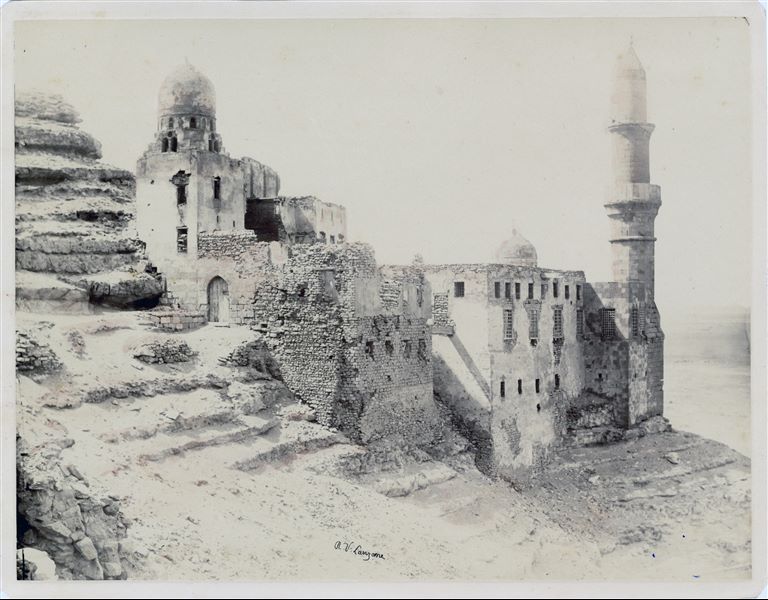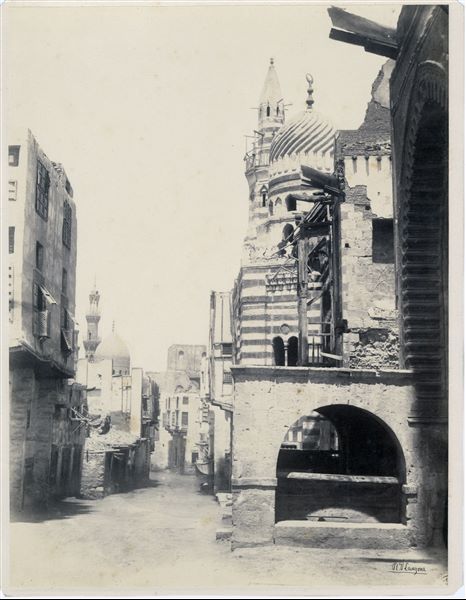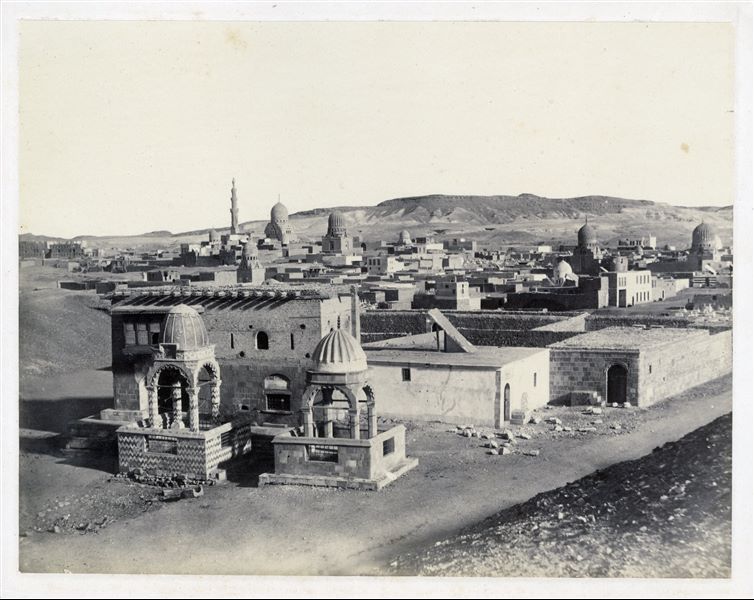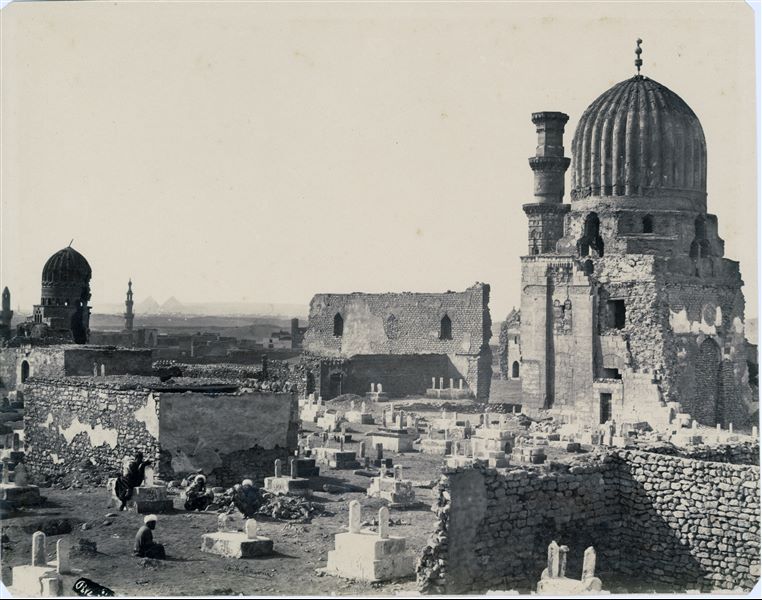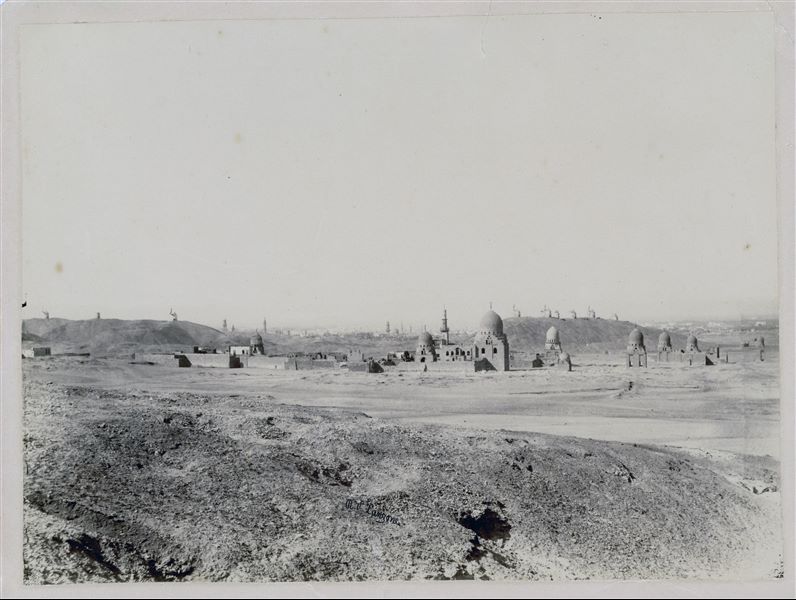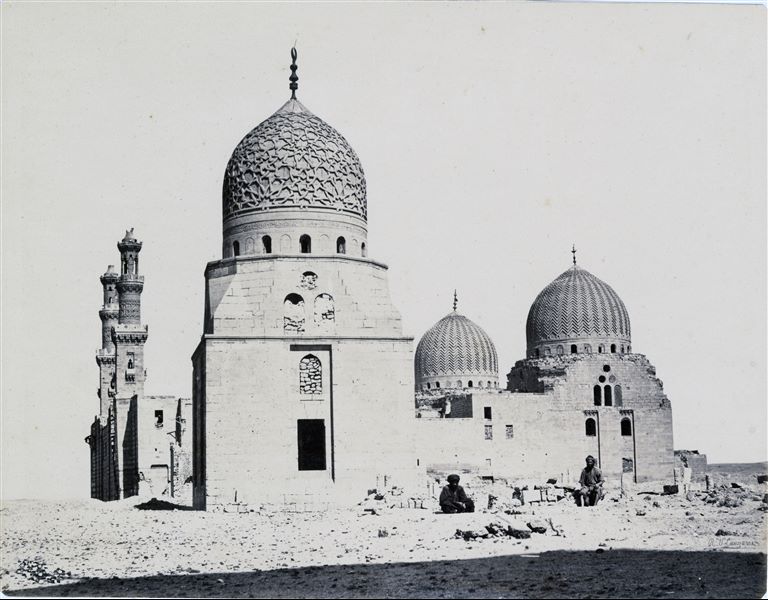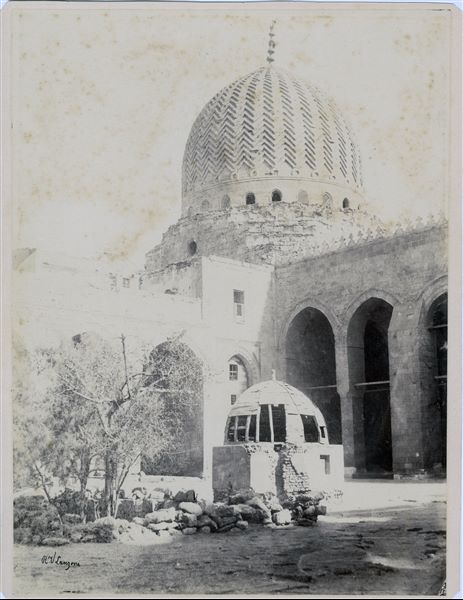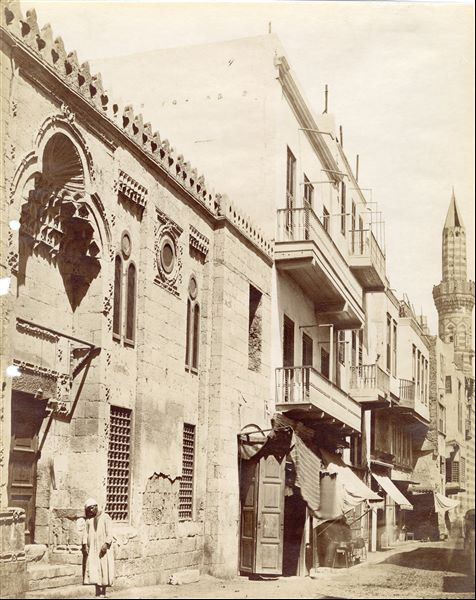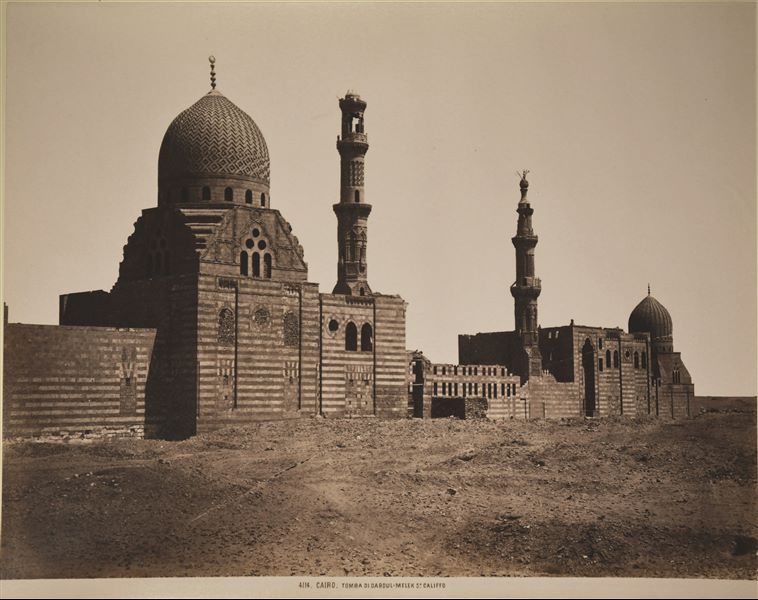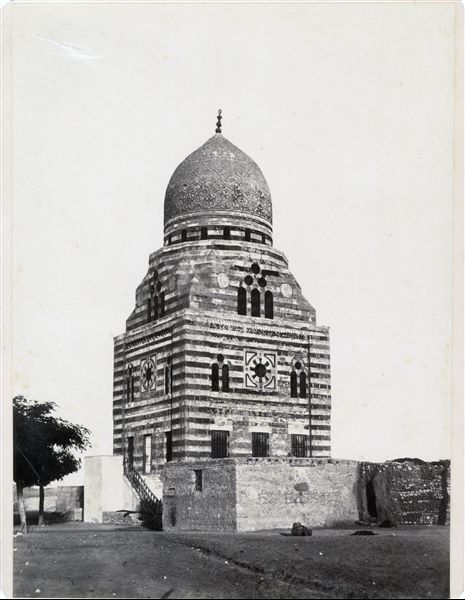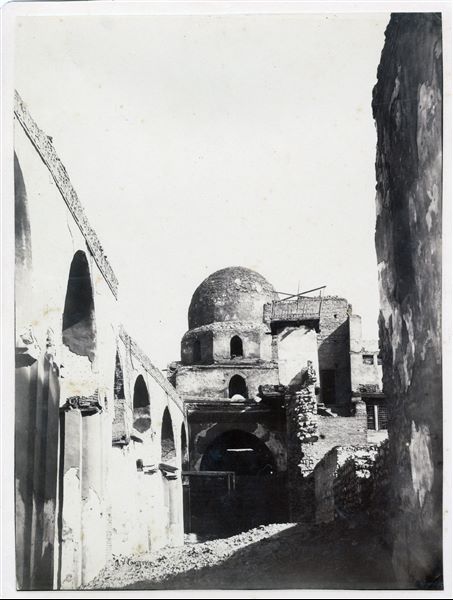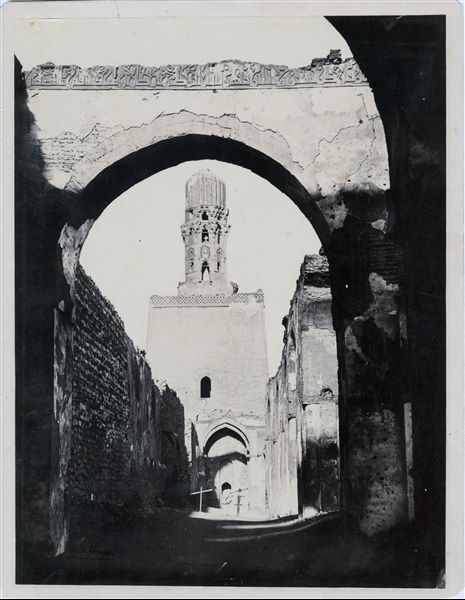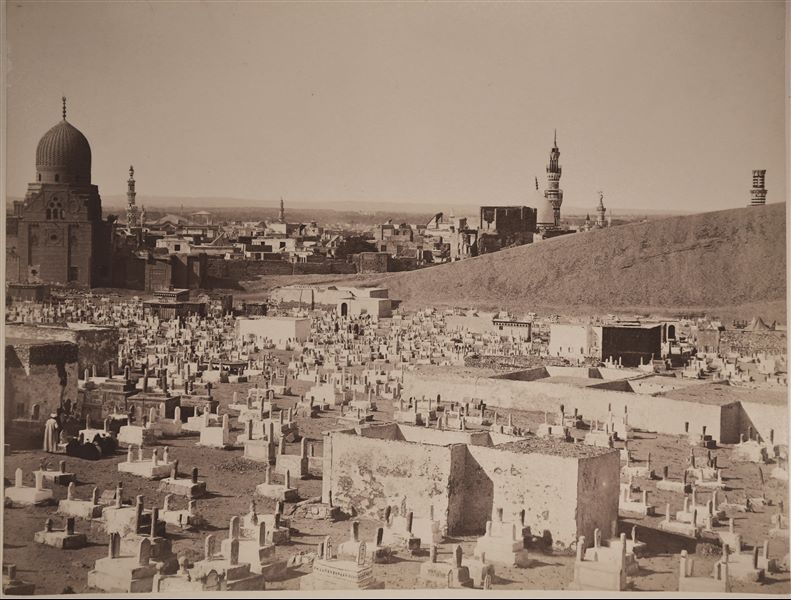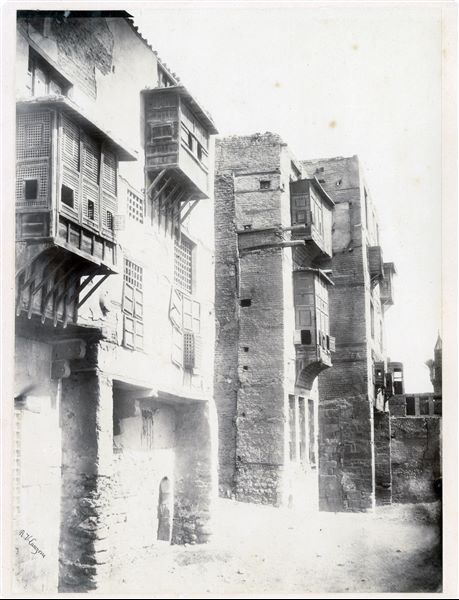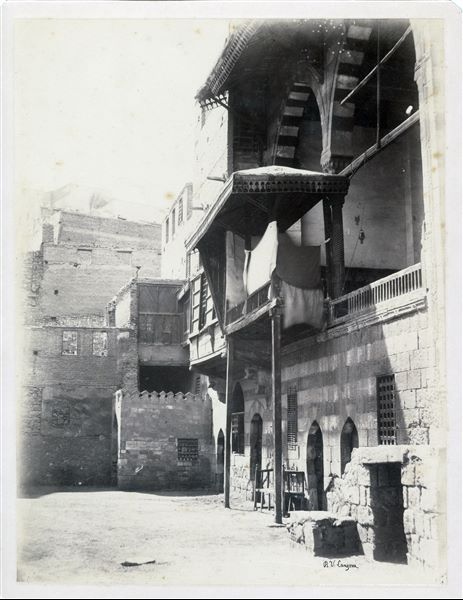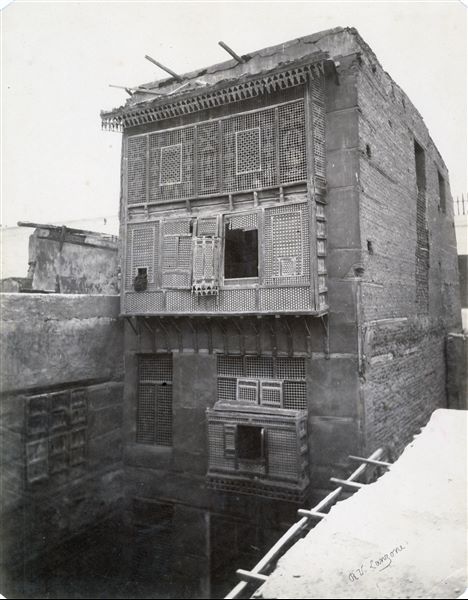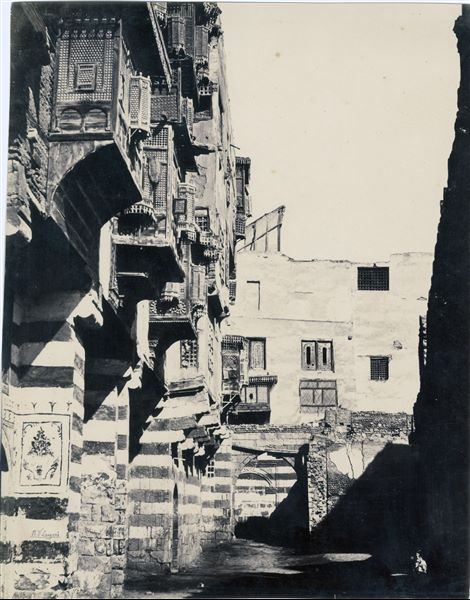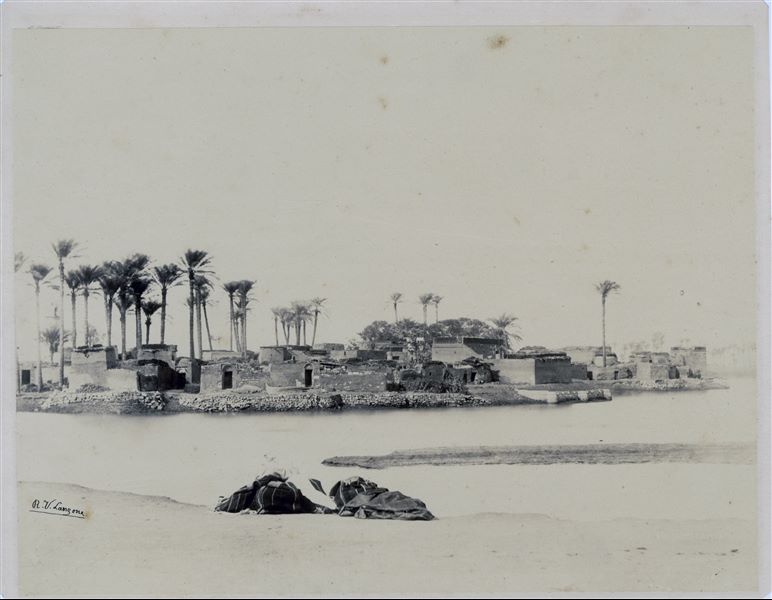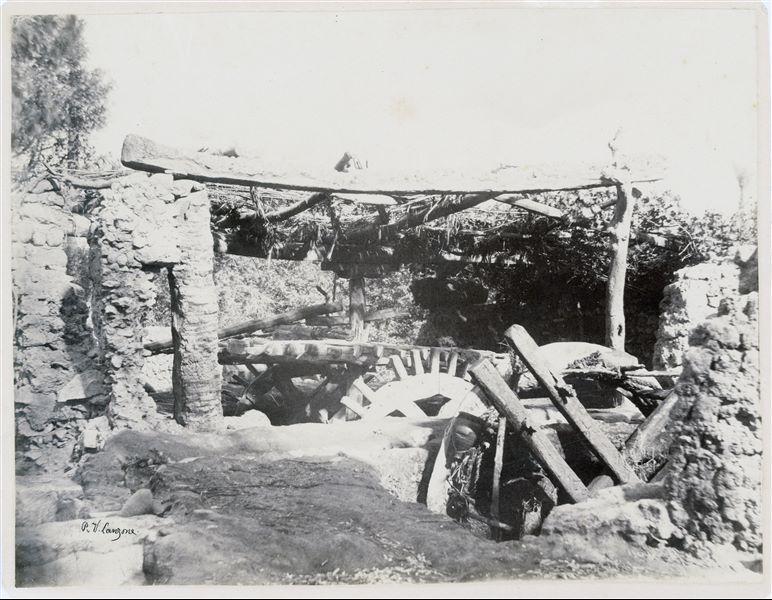Panorama of the city of Cairo, where a few mosques and minarets can be viewed in the background. In the foreground, there are remains of the medieval walls, as indicated on the back of the print. The author's signature is visible at the bottom centre.
Panorama of the city of Cairo, where several minarets and mosques can be seen. In the background on the right, there is the massive Citadel boundary wall as well as the Bab al-Azab, which is the main entrance to the Citadel, and still exists today.
Panorama of the city of Cairo, where the Citadel can be seen in the distance. Standing out on the right (albeit barely visible) is the Great Mosque, commissioned by Mohammed Ali.
View of the Cairo Citadel, over which the impressive Mosque of Mohammed Ali stands out. The author's signature is in the lower left-hand corner.
Panorama from the Cairo Citadel. In the background, the silhouettes of the Pyramids of Giza are visible.
View of the Citadel, where the Mosque of Mohammed Ali stands out, photographed from the Islamic cemetery.
Courtyard of the ‘Amr Ibn al-’As Mosque, the oldest mosque in Cairo, built in the 7th century AD by Caliph Omar in honour of the general of the Islamic troops, 'Amr Ibn al-'As, who had invaded and conquered the country a few years earlier. Nothing, however, remains of the original structure, due to modifications and remodelling over the centuries to follow. In this 19th century image, one can see the arched colonnade which still exists today, whereas the central structure has undergone some modifications over time. The author's signature can be found in the lower left-hand corner.
Panorama of the city of Cairo, showing the Citadel and the impressive Mosque of Mohammed Ali in the distance. In the foreground on the left, the spiral minaret of the Ahmed Ibn Tulun Mosque, one of the largest and oldest mosques in Cairo (9th century) is visible.
From the photo's original caption, one of the entrance doors of the 13th century Mosque of Sultan Qalawun in Cairo.
View of a section of the mosque and madrasah (place of study and education) built in the 15th century by Sultan Qaytbay in Cairo.
View of a section of the mosque and madrasah (place of study and education) built in the 15th century by Sultan Qaytbay in Cairo. The author's signature is visible at the bottom right.
View of a section of the mosque and madrasah (place of study and education) built in the 15th century by Sultan Qaytbay in Cairo.
View of the Mosque of Qani Bay al-Rammah, built in the 16th century AD in the city of Cairo. The mosque bears the name of Qani Bay al-Sayfi, nicknamed “al-Rammah”, a grand stable master of Sultan al-Ghuri, who lived between the 15th and 16th centuries. The author's signature can be found in the lower left-hand corner.
Detail of the funerary complex of Amir Khayrbak, including a mosque and a madrasah, built by the Amir in the 16th century. The author's signature can be found at the bottom.
From the photo’s original caption, detail of the Mosque-Madrasah of Sultan Hassan in Cairo, built in the 14th century. The author's signature is in the bottom right-hand corner.
View of the Mosque-Madrasah of Sultan Hassan in Cairo, built in the 14th century. Next to it, on the right, is the spot where the present-day Al Rifa'i Mosque would later be built.
View from a distance of the mosque, madrasah and minaret of Sultan Hassan in Cairo, built in the 14th century. The author's signature can be seen at the bottom right.
Panorama from the Cairo Citadel, where the Mosque-Madrasah of Sultan Hassan, built in the 14th century, stands out. Next to the building, on the right, is the area where the present-day Al Rifa'i Mosque would later be built.
View of the remains of the Shaheen Al-Khalwati Mosque, built in the 16th century on the Mokattam Hills The author's signature is visible at the bottom.
View of a street in Cairo. In the background on the left, the minarets of the Al-Rifa'i Mosque, which houses the mausoleum of part of Mohammed Ali's family and successors, including 20th century rulers including King Fuad I and King Farouk, can be seen. The author's signature is visible at the bottom right-hand corner.
View of a street in Cairo, where the minarets of the Al-Rifa'i Mosque, which houses the mausoleum of part of Mohammed Ali's family and successors, including 20th century rulers including King Fuad I and King Farouk, can be seen. The author's signature is visible at the bottom right-hand corner.
Photograph of the Great Mosque, of Viceroy Mohammed Ali, also called the "Alabaster Mosque", built between 1830 and 1848 in the Citadel, Cairo.
View of a part of the Islamic cemetery. The author's signature is slightly visible in the lower left corner.
Islamic cemetery in Cairo, where some structures including domes can be seen in a state of disrepair and in danger of collapsing. In the background, the silhouettes of two of the three Great Pyramids of Giza can be seen. The author’s signature is slightly visible at the bottom centre.
Cairo landscape. The Great Mosque built by Mohammed Ali in the Cairo Citadel is clearly visible in the background. The author's signature is at the bottom.
Panorama of a part of the Islamic cemetery in Cairo. The author's signature is at the bottom, towards the centre.
Landscape of the Northern Cemetery near Cairo, where some buildings from the Mamluk period can be seen. On the right, the two domes of the mosque and mausoleum of Sultan Faraj ibn Barquq. In the centre, the mausoleum of Gani Bek Al-Ashrafi. On the left, the funerary complex and khanqah of Sultan Ashraf Barsbay.
Islamic Northern Cemetery in Cairo, where several domes of Mamluk mausoleums can be seen. The twin domes belong to the mosque of the funerary complex and the khanqah of Sultan Faraj ibn Barquq. The author's signature is faintly visible in the bottom right-hand corner.
View of the Islamic cemetery in Cairo. In the centre, the funerary complex and khanqah of Sultan Faraj ibn Barquq, who lived between the 14th and 15th centuries. The author's signature can be seen at the bottom centre.
A view of part of the mosque and mausoleum of Sultan Faraj ibn Barquq in Cairo. The author's signature can be found at lower left.
Photograph of some mausoleums in the Islamic necropolis in Cairo. On the right, the funerary complex and khanqah of Sultan Faraj ibn Barquq, who lived between the 14th and 15th centuries.
View of a building, possibly a mosque in Cairo, with a finely worked doorway behind some plants. The author's signature can be found at the bottom right.
This shot provides a glimpse of a street (presumably) in Cairo, with an Egyptian man posing next to the elaborate entrance of a building. Along the street, the minaret of a mosque.
Photograph of a mausoleum-mosque in the Islamic cemetery in Cairo. According to the photo's original caption, it is said to be the mausoleum-mosque of Abd al-Malik ibn Marwan ibn al-Hakam (5th Caliph, who lived during the 8th century AD), however there is no evidence of this attribution today.
Detail of a mausoleum in the Islamic cemetery, built with alternating light coloured and red stones, near Cairo. The author's signature can be found at the bottom left.
View of a dome, presumably a mausoleum from the Mamluk period. The author's signature can be found at the lower left.
View of a building, presumably a mausoleum in the Islamic cemetery in Cairo. The author's signature can be found at the lower left.
Glimpse of a section of the Islamic cemetery in Cairo.
View of a section of the Islamic cemetery in Cairo.
Detail of the decorated entrance to the tomb of Sadat el-Taulbe (from the caption on the back of the photo), showing the typical ornamental style of Islamic art called arabesque, and the distinctive composition of the wooden door.
Bab al-Nasr, the “Gate of Victory”, one of the few surviving medieval gates from Cairo. The author's signature can be seen at the bottom right.
Glimpse of a street in Cairo, leading to a small gate in the city walls. Some wooden pergolas are visible near the dwellings. Note that the level of the street is lower than that of the houses, to reach them one had to use narrow steps. The author's signature can be seen at the bottom centre.
Detail of an alley in the city of Cairo, where some mashrabiyas (characteristic balconies with elaborate wooden grates) are visible. The author's signature can be found at the bottom right.
Detail of a street in the city of Cairo where some mashrabiyas (characteristic balconies with elaborate wooden grates) are visible. The author's signature can be found at the bottom left.
Detail of a street in the city of Cairo, where mashrabiyas (characteristic balconies) are visible. On the right there is an arched arcade with alternating light coloured and red stones, typical of Islamic art. The author's signature is at bottom right.
Detail of a street in the city of Cairo, showing some elaborate architectural decorations on the façades of houses, typical of Islamic art. The author's signature can be found at the bottom.
Photograph of an Egyptian dwelling presumably in Cairo. On three floors it shows the mashrabiyas, the characteristic balconies with ornate wooden grates. The author's signature can be found at the bottom right.
View of a street in Cairo, showing houses with alternating light coloured and red bricks, also featuring mashrabiyas, the characteristic balconies with ornate wooden grates. The author's signature can be found at lower left.
Detail of a particularly elaborate arched building, presumably in Cairo. Photograph unsigned but belonging to Lanzone's photo album.
View of the Nile and the typical Egyptian sailing boats known as feluccas near Cairo. A bridge is visible in the background, connecting the two banks. The author's signature is at the bottom left.
View of an area with housing and palm trees near a water basin, probably a secondary canal of the Nile which is visible in the foreground, in Cairo, the location is indicated by the caption on the back of the photograph. Due to overexposure, the image is very light. The author's signature can be seen at the lower left.

